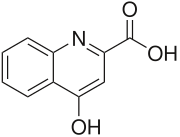Kynurenic acid
 |
|
 |
|
| Names | |
|---|---|
|
IUPAC name
4-hydroxyquinoline-2-carboxylic acid
|
|
| Other names
Kinurenic acid, kynuronic acid, quinurenic acid, transtorine
|
|
| Identifiers | |
|
492-27-3 |
|
| 3D model (Jmol) | Interactive image |
| ChEBI |
CHEBI:18344 |
| ChEMBL |
ChEMBL299155 |
| ChemSpider |
3712 |
| ECHA InfoCard | 100.007.047 |
| 2918 | |
| KEGG |
C01717 |
| PubChem | 3845 |
|
|
|
|
| Properties | |
| C10H7NO3 | |
| Molar mass | 189.168 g/mol |
| Melting point | 282.5 °C (540.5 °F; 555.6 K) |
|
Except where otherwise noted, data are given for materials in their standard state (at 25 °C [77 °F], 100 kPa).
|
|
|
|
|
| Infobox references | |
Kynurenic acid (KYNA or KYN) is a product of the normal metabolism of amino acid L-tryptophan. It has been shown that kynurenic acid possesses neuroactive activity. It acts as an antiexcitotoxic and anticonvulsant, most likely through acting as an antagonist at excitatory amino acid receptors. Because of this activity, it may influence important neurophysiological and neuropathological processes. As a result, kynurenic acid has been considered for use in therapy in certain neurobiological disorders. Conversely, increased levels of kynurenic acid have also been linked to certain pathological conditions.
Kynurenic acid was discovered in 1853 by the German chemist Justus von Liebig in dog urine, which it was apparently named after.
It is formed from L-kynurenine in a reaction catalyzed by the enzyme kynurenine—oxoglutarate transaminase.
KYNA has been proposed to act on four targets:
High levels of kynurenic acid have been identified in patients suffering from tick-borne encephalitis,schizophrenia and HIV-related illnesses. In all these situations increased levels were associated with confusion and psychotic symptoms. Kynurenic acid acts in the brain as a glycine-site NMDAr antagonist, key in glutamatergic neurotransmission system, which is thought to be involved in the pathophysiology and pathogenesis of schizophrenia.
A kynurenic acid hypothesis of schizophrenia was proposed in 2007, based on its action on midbrain dopamine activity and NMDArs, thus linking dopamine hypothesis of schizophrenia with the glutamate hypothesis of the disease.
...
Wikipedia
